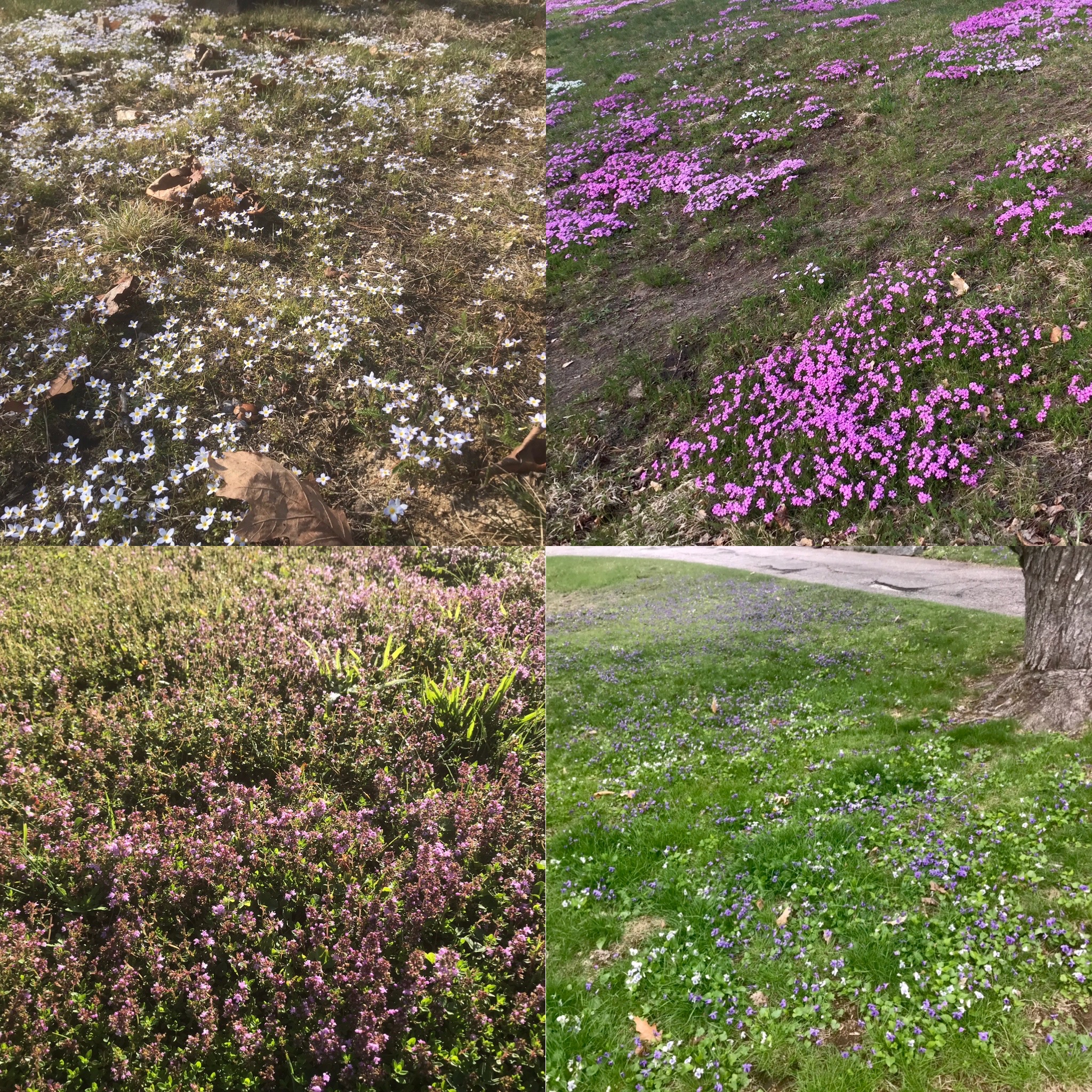For years, many homeowners in our Monadnock region have struggled to create and maintain a coveted, green lawn in the frequently sandy, thin, acid soils of our Granite State. Now as concerns mount regarding the unintended damage of lawn maintenance chemicals, the droughts continue and communities consider raising water rates on the necessary, supplemental sprinkling that traditional lawns require, it is somewhat surprising to discover both native and naturalized groundcover solutions right in our midst! Our very own Woodland Cemetery in Keene, NH is showcasing right now, several, low maintenance, seasonally-lovely options for reducing the amount of lawn you manage. Given the ever-present, Yankee frugality of municipal funding and personal observation over a decade, we can rest assured that these plants are thriving in a low-maintenance regime!
A recent, early May visit shows an impressive display of several groundcovers that are regularly used in ornamental gardens distributed thoroughly through the turf areas of the cemetery grounds. Naturalized Creeping Phlox (Phlox spp.) covers areas in carpets of pink and white for three to four weeks. Floods of native Violets bloom in white and blue blossoms from late winter all the way through to summer’s heat. Tiny white blooms of our native, Bluets (Houstonia caerulea) and Field Pussytoes (Antennaria neglecta) flow through the open lawn surrounding gravestones. Barren Strawberry (Waldsteinia fragarioides) and the ephemeral Canada Mayflower (Maianthemum canadense) make appearances as well. These flows are mixed throughout the lawn with large expanses of Creeping Thyme (Thymus spp.). While Creeping Thyme is currently an unimpressive grey-green color now, these widely distributed plants will soon showcase tiny, rose-lavender blooms that begin in the early summer and last through to the first, hard frosts. These particular plants are in open sun areas. They never receive additional watering.
Alternatively, there are a bevy of lovely mosses and native groundcovers present here as well that require no mowing. In particular, Lowbush Blueberry (Vaccinium angustifolium) and Wintergreen (Gaultheria procumbens) are distributed throughout the shadier spots of lawn. While these plants do not have showy blooms, as you might guess, Wintergreen’s foliage is evergreen. The berries of Lowbush Blueberry and Wintergreen feed several species of birds including Wild Turkey, Ring-necked Pheasant and Ruffed Grouse. These two low plants also feed Red Foxes, the Eastern Chipmunk Red Squirrels and our American Black Bears.
All of these plants, distributed throughout the lawn areas, are mown regularly by the City of Keene’s Parks & Cemetery staff. Chuck Sweeny, longtime Superintendent of Parks & Cemetery Maintenance, shared that their crews mow here every 10-14 days with no fertilizers or chemicals. They did not introduce any of these plants but assume that a family may have planted the Phlox and Thyme many years ago decorating a gravesite.
While meadow and alternative grass seed mixes abound, unfortunately seed mixes for these types of low groundcovers do not yet exist. However the Native Plant Trust’s Nasami Nursery in Whately MA sells the native plants noted above and in the photos. New Moon Nursery of WI sells plugs of the Creeping Phlox. In fact many nurseries sell the low growing varieties of Thyme and Phlox. As many of us look for ways to reduce our negative impacts on the environment, let us look to local examples of what is working well with a minimum amount of labor, polluting, petroleum fuels and destructive chemicals. Watch for a next article on a Groundcover Lawn Replacement initiative happening at the Mount Auburn Cemetery in Cambridge MA.
Michele Chalice is the owner of Keene-based, Healthy Home Habitats. You can find her at www.HealthyHomeHabitats.com as well as Facebook and Instagram.

